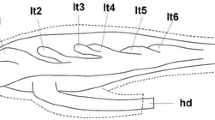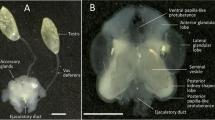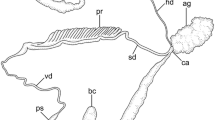Abstract.
Data on sperm storage and paternity analyses in the pulmonate land snail Arianta arbustorum suggest that the complex, multitubular sperm storage organ, the spermatheca, may influence paternity after multiple matings. Ultrastructural investigations show that the spermatheca is provided with the morphological correlates to exert cryptic female choice. However, in order to understand the function of a multitubular spermatheca it is necessary to understand how a single spermathecal tubule functions. In order to explore the potential to serve as a model for such a simple system in future experiments, the fine structure of the unitubular spermatheca and its interaction with spermatozoa were investigated in Bradybaena fruticum, another member of the Helicoidea. The spermatheca of B. fruticum is only about one-half as long as the fertilization chamber. Its epithelium is densely ciliated throughout its length. Vacuole, Golgi complex, rough endoplasmic reticulum, various vesicles, wide intercellular spaces, and an extensive basal labyrinth indicate strong secretory activity, providing the environment for sperm storage and capacitation. Prior to transfer, sperm are characterized by a perinuclear sheath and an acrosome tilted at about 50°. In the spermatheca, the perinuclear sheath is dissolved and, probably as a consequence, the acrosome folds up in line with the nuclear longitudinal axis. The spermatheca is surrounded by a network of differently oriented smooth muscle cells, which are extensively connected with each other through dense plaques. The fine structure of the muscle cells suggests that they are neither very strong nor enduring. The main function of the spermathecal musculature is certainly expulsion of sperm prior to fertilization. The musculature around the spermathecal tubule of B. fruticum appears to be a highly integrated system not allowing for much functional flexibility compared to A. arbustorum, where the muscle cells are more individualized, permitting finely tuned operations. This restricted flexibility needs to be taken into consideration in future experiments using B. fruticum as a model for the simple, unitubular sperm storage system.
Similar content being viewed by others
Author information
Authors and Affiliations
Additional information
Electronic Publication
Rights and permissions
About this article
Cite this article
Bojat, N.C., Sauder, U. & Haase, M. Functional anatomy of the sperm storage organs in Pulmonata: the simple spermatheca of Bradybaena fruticum (Gastropoda, Stylommatophora). Zoomorphology 121, 243–255 (2002). https://doi.org/10.1007/s00435-002-0062-z
Received:
Accepted:
Issue Date:
DOI: https://doi.org/10.1007/s00435-002-0062-z




